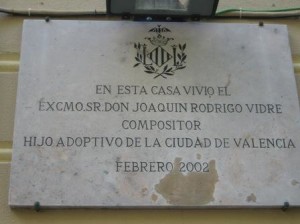Rodrigo lived in Valencia in Calle Sorní, where there is a plaque commemorating his period of residence.
When we think of Spanish art we generally think of its painters; names such as Goya, Velázquez, Dalí and Picasso generally spring to mind. When it comes to classical music however, there are fewer masters to compare with the Beethovens, Mozarts and Bachs of northern Europe.
One possible exception is Joaquin Rodrigo, whose famous Aranjuez Concert is instantly recognisable to millions and has even been adapted to Jazz by none other than Miles Davis. This excellent combination of acoustic guitar and orchestra has also been used in films such as Finding Forrester, Brassed Off and School of Rock.
Born in Sagunto on 22nd of November 1901, the youngest of ten children, Rodrigo was plunged into darkness at the age of four when a bout of diphtheria, later complicated by glaucoma, left him blind for life.
From 1906 he attended a school for the blind in Valencia, where he received his first music lessons, and from 1907 to 1922 he studied music at Valencia’s Conservatory.
In 1925, having narrowly failed to win the National Music Prize, he moved to Paris to study under Dukas. It was in Paris that he met and later married the Turkish pianist Victoria Kamhi in 1933. Despite a brief, early separation, they worked and stayed together until her death in 1997, and had a daughter named Cecilia in 1947.
The Aranjuez Concert was written while the Civil war still raged in Spain, and its melancholy melodies reflect the sadness and tragedy of those times. Although mostly written in Paris, he finished it in Madrid when the fighting had finished.
During Franco’s regime he was practically the only Spanish composer of any renown.
It is this yearning for tranquillity, the tranquillity of the Bourbon monarchs’ summer retreat at Aranjuez, that makes the music so appropriate in the film Brassed Off, starring Ewan McGregor, where it is played by the miners’ band in a moment of calm against the backdrop of the conflicts caused by the closing of the local pit, although the miners, unable to pronounce ‘Aranjuez’ refer to it as ‘Orange Juice’.
As Rodrigo explained in 1974: “It is named after the famous royal site on the shore of the River Tagus, not far from Madrid, along the road to Andalucia, and some perceive Goya’s shadow in the notes of its music, full of melancholy emotion. Its music seems to bring to life the essence of an 18th century court, where aristocratic distinction blends with popular culture. In its melody the perfume of magnolias linger, the song of birds and the whisper of fountains … Concierto de Aranjuez, a synthesis of classical and popular in both form and emotion, lies dreaming beneath the foliage of the park that surrounds the Baroque palace, and only wishes to be as agile as a butterfly and as precise as a matador’s cape pass.”
As his fame grew, Rodrigo received commissions from many famous musicians, such as James Galway and cellist Julian Lloyd Weber.
From 1947 he was a professor of music at Madrid’s Complutense University and was made Marques in 1991. He also won the Prince of Asturias Award in 1996.
He died in July 1999 and is buried alongside his wife, inevitably, at Aranjuez.


